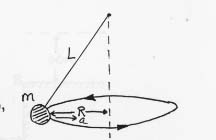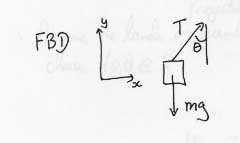Problem 2:
-
2) A yo-yo of mass m = 0.030 kg on a (massless) string of length
L= 1.0 m is swung in a circular manner as shown in the sketch
(gravity acts in the downward direction). The radius of the orbit
is R = 0.70 m.

- a) How long does it take the yo-yo to make one revolution
(i.e. what is its period?)
- b) What is the magnitude of the acceleration of the
yo-yo? Indicate the direction of the acceleration at some
instant in time on the sketch.
Solution:
This was done as a demonstration in class; the solution is in your
lecture notes from Sept. 21.
- Draw a free-body force diagram for the yo-yo:

- There are only two forces, the weight (mg) and the tension (F)
in the string. Apply
 F = ma and
we get
F = ma and
we get
- x-component: Fsin
 = ma = mv2/R
= ma = mv2/R
- y-component: Fcos
 - mg = 0
- mg = 0
- where we have recognized that a=v2/R
for circular motion. Let's solve for the velocity, since we can get
the period using v = 2
 R/T. From the y-component equation
we have
R/T. From the y-component equation
we have
- F = mg/cos

- substitute into the x-equation to get
- mgsin
 /cos
/cos = mv2/R
= mv2/R
- rearrange this to get
- v = [Rgtan
 ]1/2
]1/2
- thus the period is
- T = 2
 R/[Rgtan
R/[Rgtan ]1/2
]1/2
- Now, using sin
 = R/L we have
= R/L we have
-
 = sin-1(R/L)
= sin-1(R/L)
- = sin-1(70/100)
- = 44.4°
- thus
- T = 2
 (0.7 m)/[(0.7 m)(9.8 m/s2)tan(44.4°)]1/2
(0.7 m)/[(0.7 m)(9.8 m/s2)tan(44.4°)]1/2
- = 1.70 s
- b) We use a = v2/R and our relation given above
for v to get the acceleration
- a = (Rgtan
 )/R = gtan
)/R = gtan = 9.61 m/s2
= 9.61 m/s2
- The direction of a is radially
inward (this is what the
word "centripetal" means) is. Notice that the acceleration in this case
is nearly as large as g; one could predict this since the angle is
almost 45°....
Next Problem
Test 1
Physics 101 Home page
Physics Department Home Page
College of William and Mary,
Dept. of Physics
armd@physics.wm.edu
last updated: Oct. 2 1998


